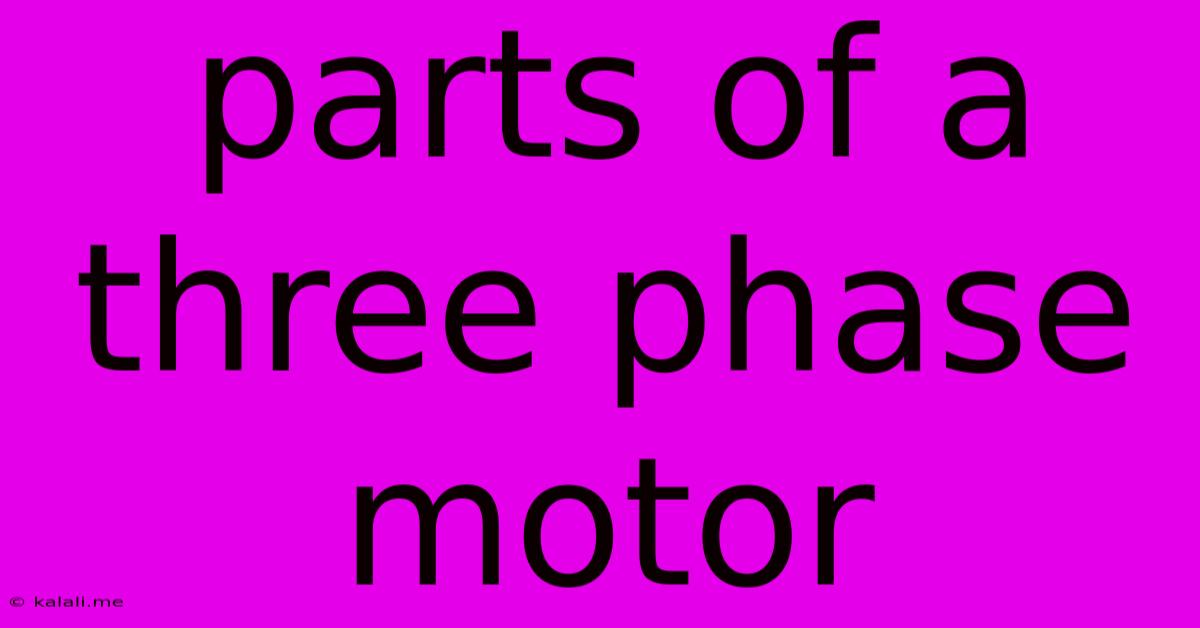Parts Of A Three Phase Motor
Kalali
Jun 15, 2025 · 3 min read

Table of Contents
Understanding the Key Components of a Three-Phase Motor
Three-phase motors are workhorses in industrial and commercial settings, powering everything from conveyor belts to pumps and compressors. Their robust design and efficient operation make them a staple in various applications. Understanding the parts of a three-phase motor is crucial for maintenance, troubleshooting, and selecting the right motor for a specific task. This article will delve into the essential components of these powerful machines.
What are the Main Parts of a Three-Phase Motor? A three-phase motor consists of several key components working together to convert electrical energy into mechanical energy. These can be broadly categorized into stator components and rotor components.
Stator Components: The Stationary Powerhouse
The stator is the stationary part of the motor, housing the components responsible for generating the rotating magnetic field. Key stator components include:
-
Stator Frame: This forms the outer casing of the motor, providing structural support and protection for the internal components. It's typically made of cast iron or aluminum, chosen for their strength and heat dissipation properties. The frame's design also contributes to the motor's overall cooling efficiency.
-
Stator Windings: These are coils of insulated copper wire precisely arranged within the stator slots. They are connected in a specific configuration (typically star or delta) to receive the three-phase power supply. The windings' arrangement determines the motor's magnetic field pattern, crucial for its operation. The quality of the winding insulation is critical to the motor's lifespan and reliability, protecting against electrical shorts.
-
Stator Core: Made of laminated steel sheets, the stator core provides a low-reluctance path for the magnetic flux generated by the stator windings. Lamination minimizes eddy current losses, improving efficiency and reducing heat generation. The core's design and material significantly impact the motor's performance characteristics.
Rotor Components: The Rotating Heart
The rotor is the rotating part of the motor, responsible for producing the mechanical output. Different types of three-phase motors have different rotor designs:
-
Squirrel Cage Rotor: This is the most common type of rotor, consisting of conductive bars embedded in the rotor core and short-circuited at both ends by end rings. The simple design results in robust and low-maintenance operation. Its construction allows for efficient current induction and torque production.
-
Wound Rotor: This type features windings similar to the stator windings, but connected to slip rings and brushes. This allows for external control of the rotor current, offering variable speed capabilities and improved starting torque, though it requires more maintenance due to the brush assembly.
-
Rotor Core: Similar to the stator core, the rotor core is made of laminated steel sheets to minimize eddy current losses. Its construction directly influences the motor's efficiency and torque characteristics.
Other Essential Components
Beyond the stator and rotor, several other crucial components contribute to the overall function of a three-phase motor:
-
Bearings: These support the rotor shaft and allow it to rotate smoothly with minimal friction. Bearing quality directly impacts the motor's lifespan and efficiency. Regular lubrication and maintenance are critical for optimal bearing performance.
-
Shaft: The shaft connects the rotor to the driven load, transmitting the rotational mechanical power generated by the motor. Its material and design need to withstand significant torque.
-
End Shields: These protect the bearings and other internal components from damage. They are integral parts of the motor’s structure, providing both protection and support.
-
Terminal Box: This houses the connections for the three-phase power supply and facilitates easy access for wiring and maintenance. Proper grounding and connection are paramount for safety and efficient operation.
Conclusion:
Understanding the individual parts of a three-phase motor is key to proper operation, maintenance, and troubleshooting. This knowledge allows for better decision-making in selecting the right motor for a given application and ensures a longer lifespan for these vital industrial components. From the sturdy stator frame to the precisely engineered rotor windings, each part plays a critical role in converting electrical energy into the reliable mechanical power that drives countless industrial processes.
Latest Posts
Latest Posts
-
Lcm Of 2 5 And 6
Jun 15, 2025
-
What Is The Chemical Symbol Of Tungsten
Jun 15, 2025
-
1 Electron Volt Is Equal To
Jun 15, 2025
-
Average Sat Score For University Of Washington
Jun 15, 2025
-
A Bias Of 10 Means Your Method Is Forecasting
Jun 15, 2025
Related Post
Thank you for visiting our website which covers about Parts Of A Three Phase Motor . We hope the information provided has been useful to you. Feel free to contact us if you have any questions or need further assistance. See you next time and don't miss to bookmark.